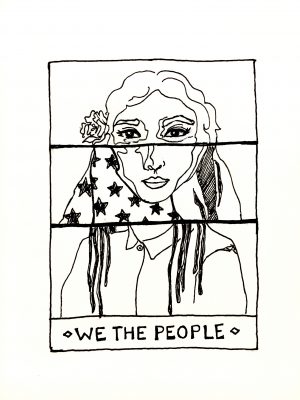Muslim Identity Challenges America
February 16, 2017

Many are familiar with “Hope,” the image of Barack Obama created by Shepard Fairey for Obama’s first inauguration in 2009. In preparation for Donald Trump’s inauguration, Fairey partnered with The Amplifier Foundation to resist hate-mongering speech. As part of their non-partisan “We the People” campaign, Fairey created three images of a Muslim, Latina and Black woman in his signature, red, white and blue color scheme.
Amongst the three, one image stands apart from the rest, visually and symbolically. In addition to the symbolic use of colors, the Muslim woman is wearing an American flag as a Hijab. The Latina and Black woman, on the other hand, do not wear the American flag on any part of their bodies.
For me, this stark visual differentiation draws special attention to the Muslim woman in comparison to the Latina and Black women. In other words, extra measures must be taken to persuade Americans that Muslims are “one of us,” folding them into the normative ideas of what it means to be American. I do recognize that the Latina woman is represented wearing a bird on her shirt that could be seen as an eagle (part of the national emblem). However, the shirt itself does not have any connection to racial or ethnic identity. Nor is the shirt the focal point of the woman’s image.
Yet for the Muslim woman represented, her hijab encapsulates her Muslim identity. In this specific image, the hijab is not only the site of Islamic values, but also of American values. The image seems to suggest that both sets of values can coexist in one individual. Ironically though, both do not have the same visual weight within the image. The flag is more visible and arguably more emotionally significant to the American people. In effect, the hijab is superseded.
The image implicitly seems to say, “Islamic values are similar to American values,” instead of, “American values are similar to Islamic values.” The sentence order is important here. It signifies which values are worthy, which are exceptional and which are being normalized. In the former, Islamic values are exceptional while American values are worthy. Furthermore, it is the American flag that is normalizing Islam. As a result, Islamic values separate from American patriotic values are implicitly left out of the image.
I’m not saying that there are no patriotic Muslim-Americans–I’m sure there are many. But, by normalizing Muslim identities through patriotic acts, only Muslims whose Islamic values agree with American values are folded into the American identity.
This merely perpetuates normative American values. In reality, people are simultaneously Muslim and American in various ways (check out Fariha Róisín and Ayqa Khan).
I understand that this is just one poster and that it is difficult to encapsulate a whole group of people in one representative body. Nevertheless, this widespread and popular campaign may be one of the few representations that people see of Muslim people, amongst an array of other misinformed representations. As such, it is important to consider how this image could have an effect on which Muslims U.S. residents implicitly believe deserve to be American.
This discussion is pertinent across the nation as the U.S. is attempting to mediate its national identity, but also at Whitman. On campus, Muslim identities are not always heard or visible due to a lack of representation. As such, this popular image may not be critically scrutinized before being used. It is crucial for Whitman student organizers and participants to consider the words and images they are putting forth in politicized spaces such as protests, gatherings and rallies.
link: http://theamplifierfoundation.org/wethepeople/



